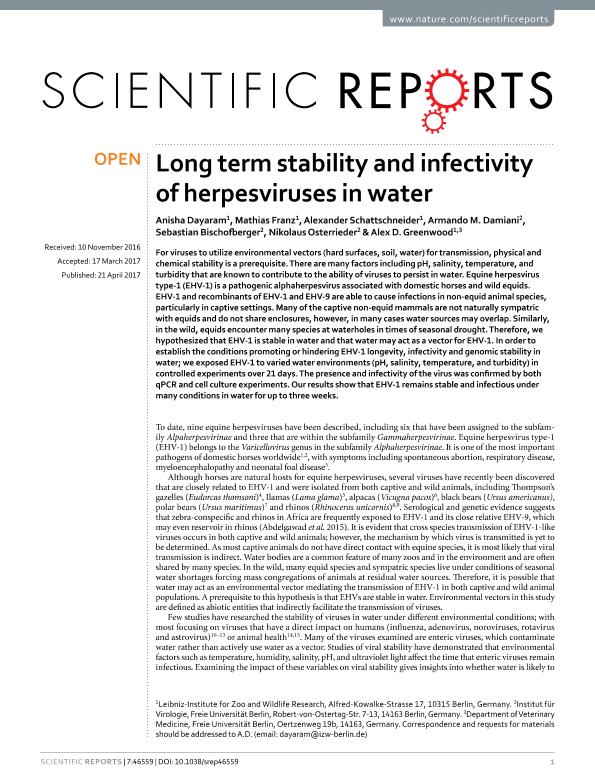Mostrar el registro sencillo del ítem
dc.contributor.author
Dayaram, Anisha
dc.contributor.author
Franz, Mathias
dc.contributor.author
Schattschneider, Alexander
dc.contributor.author
Damiani, Armando Mario

dc.contributor.author
Bischofberger, Sebastian
dc.contributor.author
Osterrieder, Nikolaus
dc.contributor.author
Greenwood, Alex D.
dc.date.available
2018-06-22T19:51:01Z
dc.date.issued
2017-04
dc.identifier.citation
Dayaram, Anisha; Franz, Mathias; Schattschneider, Alexander; Damiani, Armando Mario; Bischofberger, Sebastian; et al.; Long term stability and infectivity of herpesviruses in water; Nature Publishing Group; Scientific Reports; 7; 4-2017; 1-10
dc.identifier.issn
2045-2322
dc.identifier.uri
http://hdl.handle.net/11336/49746
dc.description.abstract
For viruses to utilize environmental vectors (hard surfaces, soil, water) for transmission, physical and chemical stability is a prerequisite. There are many factors including pH, salinity, temperature, and turbidity that are known to contribute to the ability of viruses to persist in water. Equine herpesvirus type-1 (EHV-1) is a pathogenic alphaherpesvirus associated with domestic horses and wild equids. EHV-1 and recombinants of EHV-1 and EHV-9 are able to cause infections in non-equid animal species, particularly in captive settings. Many of the captive non-equid mammals are not naturally sympatric with equids and do not share enclosures, however, in many cases water sources may overlap. Similarly, in the wild, equids encounter many species at waterholes in times of seasonal drought. Therefore, we hypothesized that EHV-1 is stable in water and that water may act as a vector for EHV-1. In order to establish the conditions promoting or hindering EHV-1 longevity, infectivity and genomic stability in water; we exposed EHV-1 to varied water environments (pH, salinity, temperature, and turbidity) in controlled experiments over 21 days. The presence and infectivity of the virus was confirmed by both qPCR and cell culture experiments. Our results show that EHV-1 remains stable and infectious under many conditions in water for up to three weeks.
dc.format
application/pdf
dc.language.iso
eng
dc.publisher
Nature Publishing Group

dc.rights
info:eu-repo/semantics/openAccess
dc.rights.uri
https://creativecommons.org/licenses/by-nc-sa/2.5/ar/
dc.subject
Ehv-1
dc.subject
Stability
dc.subject.classification
Otras Ciencias Biológicas

dc.subject.classification
Ciencias Biológicas

dc.subject.classification
CIENCIAS NATURALES Y EXACTAS

dc.title
Long term stability and infectivity of herpesviruses in water
dc.type
info:eu-repo/semantics/article
dc.type
info:ar-repo/semantics/artículo
dc.type
info:eu-repo/semantics/publishedVersion
dc.date.updated
2018-06-18T19:08:57Z
dc.journal.volume
7
dc.journal.pagination
1-10
dc.journal.pais
Estados Unidos

dc.journal.ciudad
Nueva York
dc.description.fil
Fil: Dayaram, Anisha. Leibniz Institute For Zoo And Wildlife Research; Alemania
dc.description.fil
Fil: Franz, Mathias. Leibniz-institute For Zoo And Wildlife Research; Alemania
dc.description.fil
Fil: Schattschneider, Alexander. Leibniz-institute For Zoo And Wildlife Research; Alemania
dc.description.fil
Fil: Damiani, Armando Mario. Consejo Nacional de Investigaciones Científicas y Técnicas. Centro Científico Tecnológico Conicet - Mendoza. Instituto de Medicina y Biología Experimental de Cuyo; Argentina. Freie University Berlin; Alemania
dc.description.fil
Fil: Bischofberger, Sebastian. Freie University Berlin; Alemania
dc.description.fil
Fil: Osterrieder, Nikolaus. Freie University Berlin; Alemania
dc.description.fil
Fil: Greenwood, Alex D.. Leibniz-institute For Zoo And Wildlife Research; Alemania
dc.journal.title
Scientific Reports
dc.relation.alternativeid
info:eu-repo/semantics/altIdentifier/url/http://www.nature.com/articles/srep46559
dc.relation.alternativeid
info:eu-repo/semantics/altIdentifier/doi/http://dx.doi.org/10.1038/srep46559
Archivos asociados
